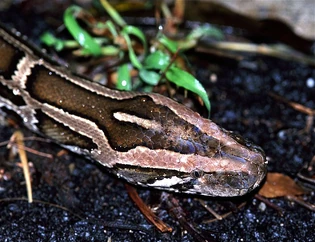|
Burmese Python | |
|---|---|
| Invasive Status | |
| Highly invasive | Population increasing |
| Natural Range | |
| |
| Introduced Range | |
| |
| Pathways | |
| Pet trade | |
| Issues | |
|
Predation of native species Outcompeting natives for food | |
| Removal Methods | |
|
Active culling via hunting | |
The Burmese python (Python bivittatus) is one of the largest snakes alive on planet Earth. It is native to south-east Asia and is a large, predatorial constrictor, with a diet of medium-sized birds and mammals. With the pet trade acting as the main transfer pathway, the Burmese python is perhaps the largest of all predatorial invaders.
Range[]
Native Range[]
The Burmese python is native to south-east Asia, from Bangladesh through Myanmar and extreme-south China down to southern Thailand. It is also resident in the Indonesian locations of Java, Mali, Sumbawa and south-west Sulawesi. [1]
Introduced Range[]
The Burmese python has been introduced to the United States of America. More specifically, it resides in the Everglades of South Florida. Over 2000 snakes have been removed since 2001, with the total population likely being far higher. [2] Estimates for the total wild population of Burmese pythons range from 30,000 to 100,000 snakes. [3]
An adult 12-foot Burmese python was famously caught in a river in Puerto Rico, sparking fears that the species has become established there. However, no other sightings have been recorded and the individual is probably a one-off escapee. [5]
Pathways and Introduction[]
It is believed that the most notable pathway for the Burmese python is via the pet trade. Burmese pythons are popular as exotic pets but, due to the adult's large size, they often outgrow their owners' expectations. Unsure of how to deal with the issue, some owners then release the pythons into the wild. Other pythons may have been escapees. [2]
Effects[]
Burmese pythons are predators and, whilst they scarcely attack humans, they will eat medium-sized birds and mammals, such as raccoons, rabbits, foxes and bobcats. [3]
Control and Removal Methods[]
The main method of control for the Burmese python populations in Florida is capture. Searching with the use of dogs has been trialed and it has been observed that dog-aided search teams are able to cover a larger area more quickly than groups without dogs, but other factors such as cost limit the practicality of dog use. [4]
Import of Burmese pythons, as well as three other species of large snake, without a permit has been prohibited in the USA under the Lacey act. [4]
